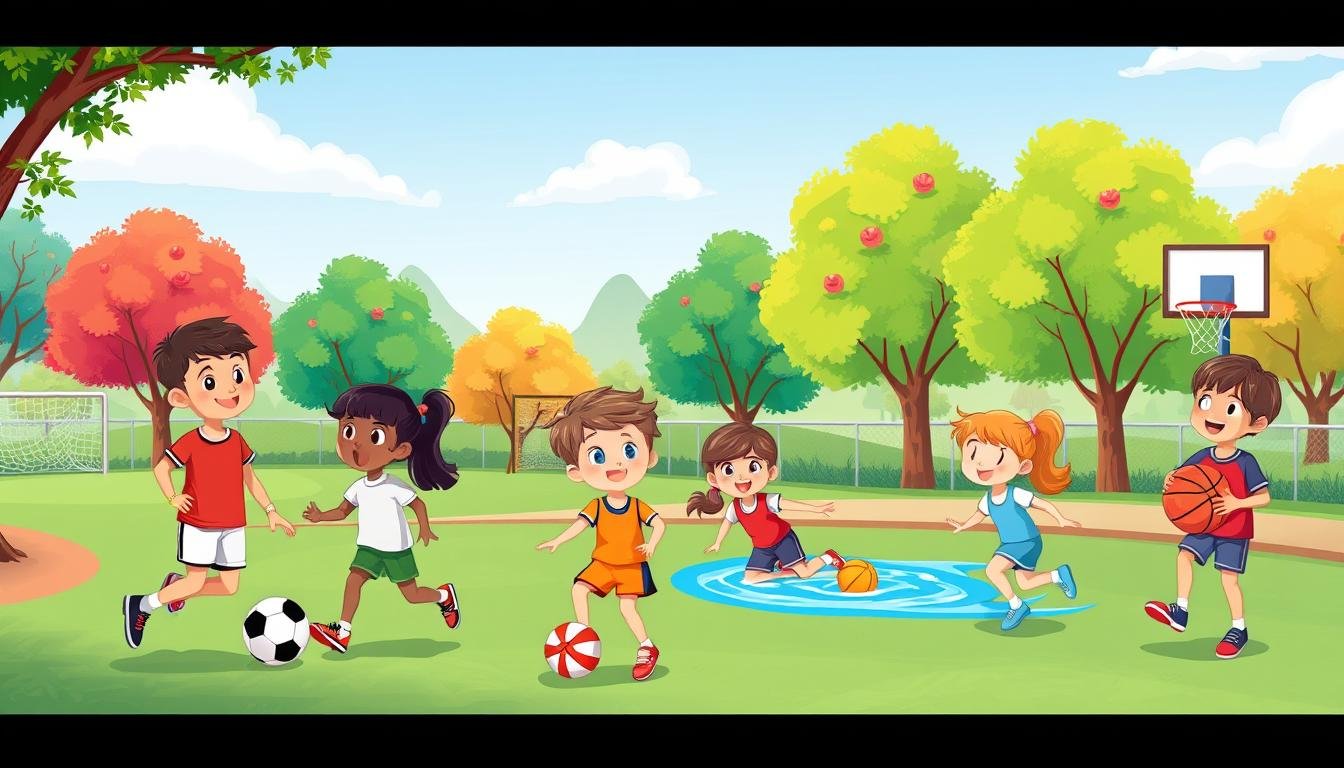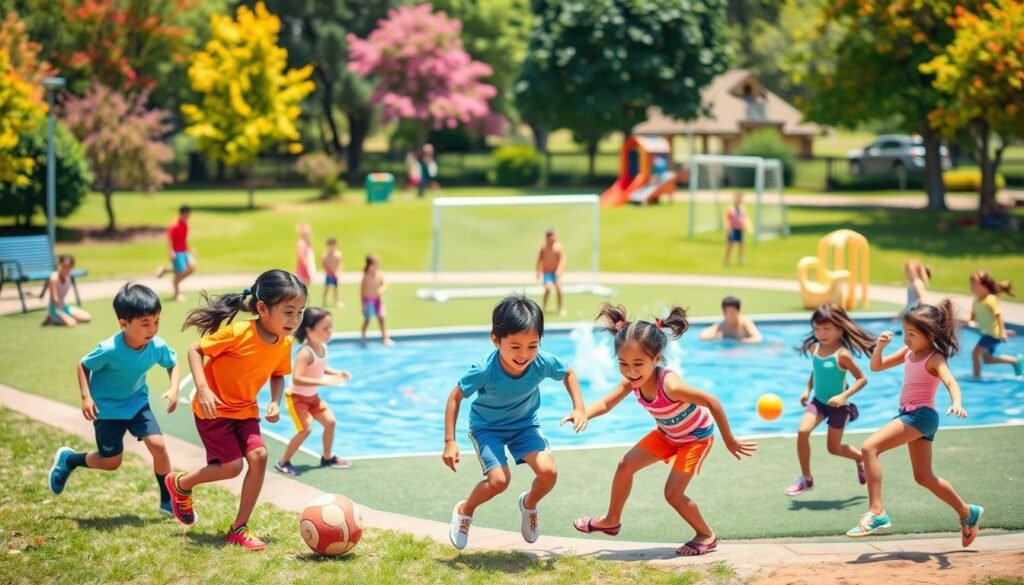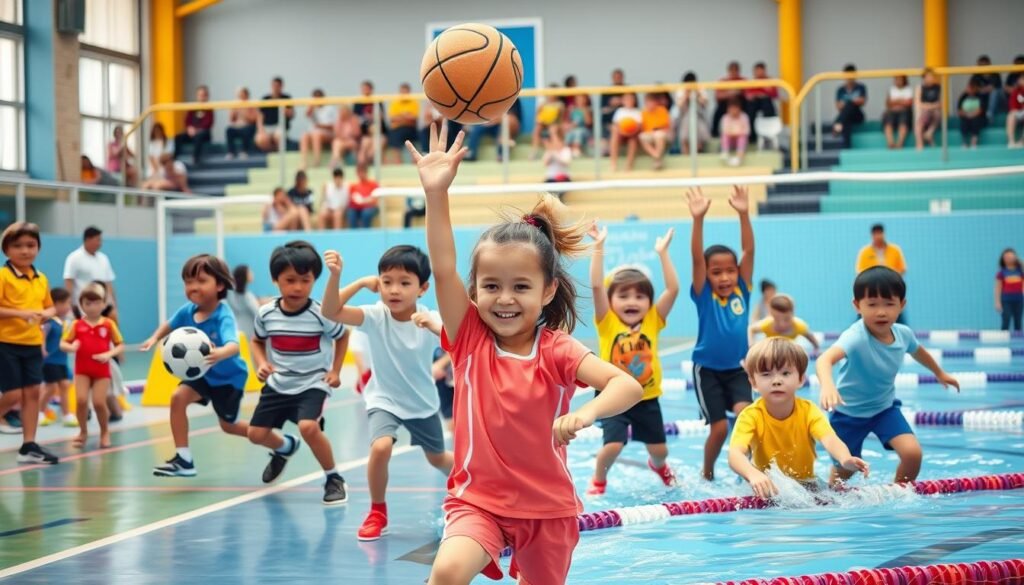Which sport to choose for my child according to his age

Choosing the right sport for your child can be both thrilling and challenging. It’s not just about picking any sport. It’s about finding the perfect one to make their life better. When deciding, age is a key factor to think about.
Knowing the right sports for kids at different ages is crucial. It helps match their physical abilities and growth needs. This ensures they get the most out of their sports experience.
Whether your child is a toddler or a teenager, understanding sports for kids is important. It can greatly impact their growth and development. This guide will help you navigate through the different stages of youth. You’ll learn how to pick the best sports for your child at each age.
Key Takeaways
- Importance of considering a child’s developmental stage when choosing sports.
- Insight into the benefits of sports specific to various age groups.
- Role of parents in facilitating appropriate sports activities for their children.
- How age-appropriate athletics contribute to the overall growth of the child.
- Strategies to encourage consistent youth sports participation.
Understanding the Benefits of Sports for Kids
Sports are more than just fun and games. They have a big impact on kids’ lives. Playing sports helps kids grow physically, emotionally, and socially.
The Role of Active Play in Child Development
Active play is key for kids’ early growth. It boosts physical and mental skills, and helps with emotional health. Activities like running and throwing improve motor skills and balance.
How Youth Sports Foster Life Skills
Youth sports teach important life skills like teamwork and discipline. They help kids handle winning and losing, building resilience. These skills are useful in facing challenges in life.
Youth Fitness: Building a Foundation for Healthy Living
Youth fitness is about more than just sports. It sets the stage for a healthy life as an adult. Exercise helps keep a healthy weight and reduces disease risk. Sports make exercise fun and effective for kids.
Selecting Age-Appropriate Sports
Choosing the right sports for your child is key for their growth. It’s important to pick sports that fit their age group. This way, kids can have fun and learn a lot from their experiences. Let’s look at the best sports for toddlers, preschoolers, and school kids.
Children’s Athletics: What’s Suitable for Toddlers?
For toddlers, focus on basic skills and fun games. Toddlers are starting to learn about their bodies. They need games that are easy and fun, without competition. Here are some examples:
- Playing with soft, oversized balls to improve hand-eye coordination.
- Simple running games that encourage movement and basic agility.
- Balance games, which can be as simple as walking along lines or up gentle inclines.
These activities help toddlers learn basic motor skills in a fun way.
Engaging Preschoolers in Sports Activities
Preschool sports should still be fun and not competitive. But, they can start to get a bit more structured. Kids at this age can do more coordinated actions. Good activities for preschoolers include:
- Tag and similar chase games that refine agility and speed.
- Jump rope and hopscotch, which improve timing and rhythm.
- Basic gymnastics or tumbling routines that foster balance and strength.
These activities keep preschoolers active and help them learn new skills.
Guiding 6-12 Year Olds in Choosing Sports
As kids get older, they can handle more challenging sports. Team sports and strategy games are great for this age. They help kids learn to work together and solve problems. Good sports for this age include:
- Soccer, which can help with endurance and teamwork.
- Martial arts, focusing on discipline and self-control.
- Swimming, which promotes cardiovascular health and strength.
These sports are perfect for teaching older kids about teamwork and personal growth through sports.
Incorporating Physical Education for Kids
Today, adding physical education for kids to school is key. It’s not just about being fit. It also helps kids grow smarter and stronger together. This mix makes learning fun and prepares them for life.
Integrating Sports With Academic Learning
Mixing sports with school work changes how we learn. It helps kids focus better and do well in school. Schools that do this see their students more excited and eager to learn.
By linking sports with subjects like math or science, kids see how everything connects. This shows the power of integrating sports with academics.
The Importance of Structured Physical Activity
Structured sports for kids build a strong, healthy life. These classes meet kids’ needs, teaching them to stay active. They also improve skills like teamwork and leadership.
Physical education is vital for kids’ growth. It affects their body, mind, and social skills. By integrating sports with academics and offering structured physical activities for children, schools help students succeed in all areas.
The Significance of Kids Sports Programs
Kids sports programs are more than just a place for kids to play. They help kids grow in many ways. These programs are key for youth sports development.
Sports development for kids is not just about physical health. It also teaches social skills, teamwork, and responsibility. These skills help kids do well in school and feel good about themselves.
- Enhanced physical health
- Improved emotional resilience
- Stronger social connections
Choosing the right program is important. Parents should pick programs that fit their child’s interests and age. The focus should be on fun, learning, and growing, not just winning.
These programs provide a scaffold for lifelong sports engagement and physical fitness, setting a foundation that extends well beyond childhood.
Local community centers offer many kids sports programs. They have programs for different ages and skill levels. These programs help kids connect with their community and grow healthy.
In conclusion, kids sports programs are vital for kids’ growth. They help kids stay healthy and become well-rounded adults.
Finding the Right Sports Activities for Children
Finding the right sports for kids can be both fun and challenging. The number and types of youth sports options differ by location. It’s important to choose activities that help kids grow physically, socially, and personally.
Evaluating Local Youth Sports Options
Start by looking at what your community offers. From soccer to swimming, each sport has its own benefits. Research local clubs, centers, and schools to find the best options.
Talking to other parents and going to sports events can also help. You’ll learn about the quality and support of different programs.
Customizing Kid’s Sports Choices to their Interests
To help kids love sports, match their interests and abilities. Find out what sports they’re excited about. Then, look for programs that fit their age and skill level.
Personalization goes beyond just the sport. It also means considering their schedule and making sure the sport fits into their life.
- Introduce them to various sports to build versatility and interest.
- Keep talking to your child to make sure they enjoy the sports they’re in.
By carefully choosing and tailoring sports options, parents can greatly benefit their kids. The aim is to help them enjoy fitness for life, starting early.
Promoting Youth Sports Participation
Active play and sports have many benefits, improving both physical health and social skills. This makes promoting youth sports very important for today’s parents. By making active play a regular part of their lives, parents can greatly help their children grow and view sports positively.
How Parents Can Encourage Regular Active Play
Encouraging active play is more than just signing kids up for sports. It’s about being involved. Parents can help by joining in, making sure sports gear is available, and setting a routine for physical activities. These simple steps can spark a lifelong passion for sports.
- Lead by example by participating in sports yourself.
- Set up a play area in your home where kids can freely access sports equipment.
- Encourage your child to invite friends over for informal games.

The Impact of Parental Support on Sports Development
Parental support in sports is more than just being there at games. It’s about emotional support, practical help, and positive feedback. Research shows that kids do better and enjoy sports more when their parents show real interest.
Encouragement in any form is crucial – whether it’s praise for effort, celebrating small victories, or providing constructive feedback.
To really help your child love sports, consider:
- Always attending your child’s games and practice sessions.
- Talking about the ups and downs of sports.
- Helping out with organizing or volunteering for their events.
By using these strategies every day, parents can greatly support promoting youth sports and encouraging active play. This sets the stage for healthy, active lives.
Addressing Safety in Children’s Athletics
Keeping kids safe in sports is a big deal for parents, coaches, and sports groups. As more kids get into sports, making sure they’re safe is key. This helps avoid injuries and keeps them in a safe place.
- Using the right protective gear for each sport, like helmets for biking and padding for football.
- Making sure playing areas are safe and kept up to avoid accidents.
- Having enough adult supervision and making sure coaches know sports and first aid.
- Keeping safety rules up to date and making sure everyone follows them.
- Telling young athletes to report injuries and not play if they’re hurt.
It’s not just about the gear. Teaching kids the right techniques and how to stay aware is also crucial. This helps them stay safe and grow in sports.
By focusing on prevention, we make sports safer and more fun for young athletes.
Creating a place where safety in children’s sports is as important as the game itself is essential. This way, sports can be a positive part of kids’ lives, helping them grow physically, socially, and emotionally.
Sport for Kids: Matching Passions with Age-Related Capacities
Introducing kids to sports is a careful balance. It’s about matching their passions with their growing abilities. Knowing age-related capacities in sports helps them enjoy and succeed in sports.

When to Start Competitive Sports
Choosing the right time for kids to start competitive sports for kids is tricky. It’s not just about physical skills, but also emotional readiness. Usually, kids are ready around age six or seven.
But, it’s important to see if they really want to compete, not just play for fun.
The Balance Between Challenge and Skill in Youth Sports
Finding the right balance in youth sports is key. It keeps sports fun and helps kids grow. Sports programs should match their skills with the right challenge.
This way, kids grow as athletes and individuals. Sports tailored to their age-related capacities help them stay fit, work as a team, and develop personally. By matching the sport’s demands to their stage of development, we help them become confident and skilled young athletes.
Conclusion
In this article, we’ve covered a lot about choosing sports for kids. We talked about how important youth fitness is and the many sides of sports development for children. These points show how crucial it is to pick the right sports for kids. They should match their age and help them love moving and staying healthy.
Parents are key in helping kids with sports. They can encourage kids to join sports that fit their interests and skills. This helps kids learn important lessons like hard work, teamwork, and self-control. It’s important for families to work with local sports programs to help their kids grow and have fun.
Our journey ends with a big goal: to help kids start a lifelong love for being active and healthy. As kids get older and better at sports, their early experiences can spark a lifelong passion for fitness. So, youth sports are more than just games. They teach kids about their bodies, minds, and how to live life fully and happily.



